All you need to know about your products!

| 3DNews Vendor Reference English Resource - All you need to know about your products! |
||||||
 |
||||||
|
|
||||||
GeCube Radeon X700 PRO AGP 128MbAuthor:Date: 30/05/2005 No hyped announcements. No official presentations. ATI's last of the Mohicans of the generation AGP, the once spicy food for talk in the corridors, is finally there on the table of our test lab not just a sample of aka Press Edition but as a full-fledged batch-produced solution. 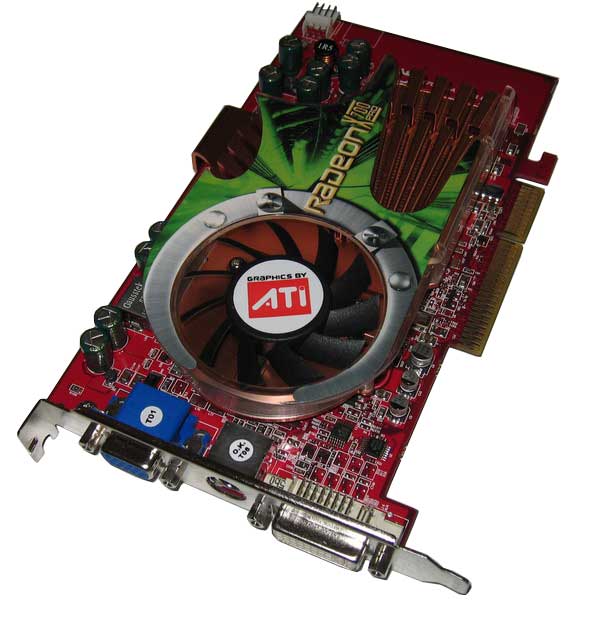 Although many other partners of the Canadian company have also released their boards on the base of RX700 PRO AGP, GeCube whose products we have repeatedly reviewed proved to be smarter than others, so it's just this that solution which has acquired the the honorable title of a pioneer. With this batch-produced card, we'll find out the capabilities of the new solution by ATI and thus will return a verdict on the advisability of purchasing a board on the base of RX700 PRO AGP to date. Having decided to conquer the modern mainstream market of AGP video cards, ATI set foot on a slippery ground because this field has been occupied for several months by the already recognized minions whose names are GeForce 6600GT and 6600 products of the beloved competitor - NVIDIA. Having gained their steadfast positions to date, they will certainly not give in their domain without a fight. Therefore, our task is to find out how steadfast ATI's positions are, and if ATI has any chance to score a goal of prestige into the green gates on the AGP stadium. Indeed, in due time NVIDIA got quite an easy victory on that ground. While ATI was furrowing the expanses of the PCI-E market breaking new grounds and sowing the plough-lands with their newly-baked solutions, NVIDIA, apart from promoting PCI-E boards, with the aid of its faithful partners was actively making and releasing inexpensive modern and powerful cards equipped with the HSI bridge. ATI's first AGP solutions of the new generation have become the top-end RX850XT (PE) built on R481 with the native support for AGP, as well as RX800 and RX800XL equipped with the RIALTO bridge which we reviewed in our previous materials. RX700 PRO AGP is also based on the already familiar RV410 chip, and support for the AGP is implemented via the RIALTO bridge positioned on the board's reverse side. The nominal memory operating frequency on the 128Mb make of the card (there is also RX700 PRO AGP equipped with 256Mb of video memory) has gone up a bit as compared to the PCI-E analog (860MHz DDR) and amounts to 945MHz DDR. The nominal operating frequency of the graphic processor has remained unchanged - 425 MHz. Of course, success of the solution and its artistic value to the consumer will be made clear by the price because in this sector the price is one of the top priority when buying a video card. The situation with prices, at least those recommended, is going well enough - $199 for the 256Mb make, and $149 - for RX700 PRO AGP equipped with 128Mb of video memory which we are just reviewing today. So, $149. What is NVIDIA offering to us in this price range?! At that, a very interesting situation is shaping up. To date, GeForce 6600GT can be already made available at $170 onwards. The other side has been taken by GeForce 6600 whose current price starts with $110. That is, RX700 PRO AGP 128Mb is precisely between these millstones. Therefore, both GeForce 6600GT and GeForce 6600 are taking part in our benchmarking session. It would be also quite cognitive to have a look at a comparison of the novelty versus Radeon 9800 PRO which has long been holding defense in the mainstream sector of AGP solutions and resisting with fortitude to the powerful onset by GeForce 6600GT. Currently, the price for this board is about $160-180 (+/-, depending on the manufacturer and sales outlets). That is, it also falls within the category of rivals to RX700 PRO AGP. GeCube RX700 PRO AGP FeaturesPackage bundle:
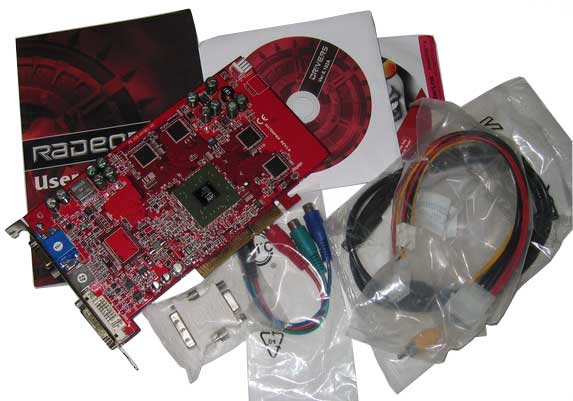 What catches the eye first is the cooling system. It offers a concept traditional for GeCube products - a large copper-styled aluminum radiator with a fan of the board's front side, covering the GPU and four video memory chips. Nor has the reverse side of the board been forgotten - there is a copper-styled aluminum plate installed on it. The cooling system is fastened with two screws. Note that the plate on the reverse side is no more than a decoration because all the four video memory chips are on the front side of the board. However, let's not forget that in GeCube's product lines, like those by other manufacturing companies, there is also a 256Mb make of RX700 PRO AGP. If we look at the reverse side of the board without a radiator, we can see that the space for four video memory chips has been wired. To prevent the board and the RIALTO bridge from damages upon contacting the radiator, there are protective spacers between them. 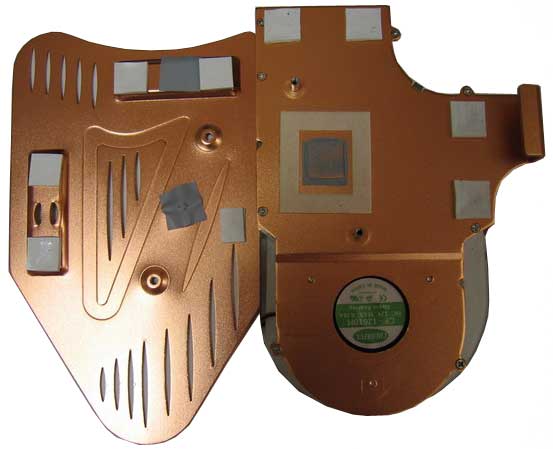 As the thermo interface, the manufacturer uses "jewel steel" paint for the GPU and the thermal spacer for the video memory chips. The card is equipped with 128Mb of GDDR3 memory with a 128-bit data transmission bus assembled of eight Infineon BGA memory chips of 2 ns access time, which is equivalent to 500 MHz (1000 MHz DDR) operating frequency. The standard memory operating frequency in RX700 PRO AGP 128Mb is 945 MHz DDR. That is, in theory we can expect an overclocking up to 1000MHz DDR, the nominal frequency of the video memory. But we'd better not run ahead, so let's look at the practical results which we are presenting in what follows. The positioning of the memory chips is such that all the four chips are placed on the front side of the PCB. 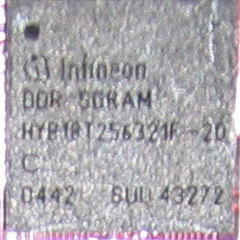 The graphic processor of RV410 (X700) runs at 425MHz, which is the same as on the PCI-E make of RX700 PRO. There are 8 pixel pipelines, and 6 vertex units. 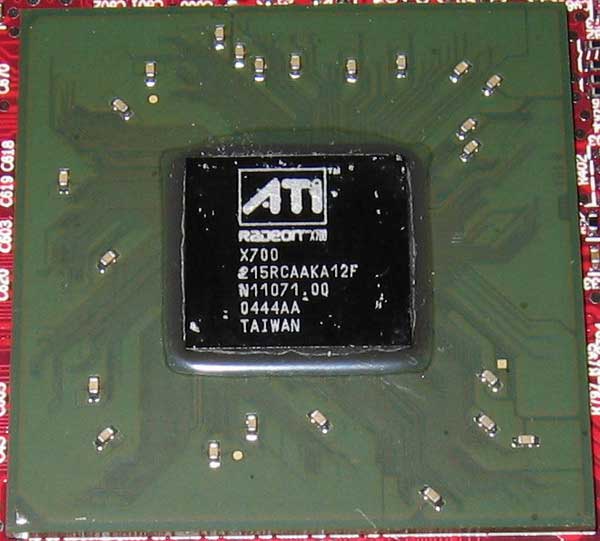 Let's take a look at the onboard connector for additional power supply. It was not provided on RX700 PRO PCI-E. On the AGP-version, the connector is identical to what is used for plugging in power to the HDD, but there shouldn't be any issues with connection because a respective adapter comes as a bundled item. 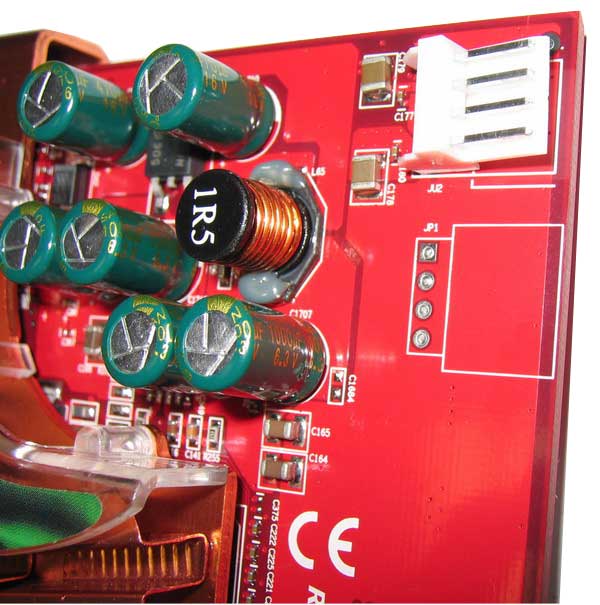 Let's also look at the RIALTO bridge with which the AGP interface is supported 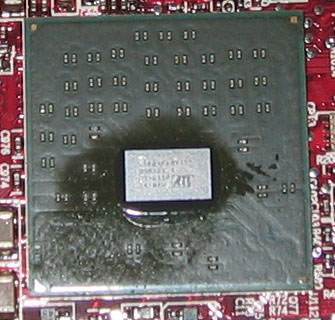 Also, look at the kit of outputs - analogous, digital, and S-Video  Note that unlike the PCI-E analog, the RX700 PRO AGP does not offer support for the VIVO. The space for it has been wired, but the ATI Rage Theater chip hasn't been installed. Now on to benchmarking. Test configuration
To test the ATI video cards, we used the latest Catalyst 5.4 WHQL-drivers, and ForceWare 76.44 beta drivers - for NVIDIA cards OverclockingAs we remember, PCI-E boards built on RX700 PRO did not stand out with phenomenal overclocking capabilities. There were exceptions like Sapphire's RX700 PRO Toxic where using proprietary utilities you could raise the clock speeds and thus increase the performance. As regards the AGP version, we were able to overclock the GPU to 470MHz. Therefore, the overclock has reached 45 MHz (the standard frequency is 425 MHz). We were able to overclock the video memory originally running at 945MHz DDR (access time for the chips is 2 ns) to merely 1000MHz DDR. Therefore, the 2 ns memory ran at its nominal speed, no megahertz higher than that. Certainly, it is not reasonable to stick a label to all similar products having experienced a not quite successful overclock with a particular specimen of the card. We are not doing that, nor recommend that to you. The overclocking capability varies from specimen to specimen, sometimes quite substantially. In conclusion, note that the cooling system did not undergo any upgrade, we ran the tests with an open test-bench, with the ambient temperature being about 25 C. 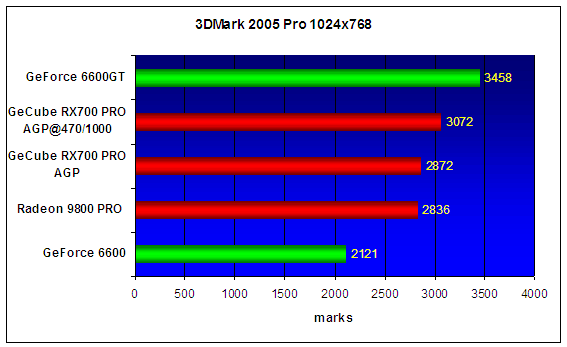 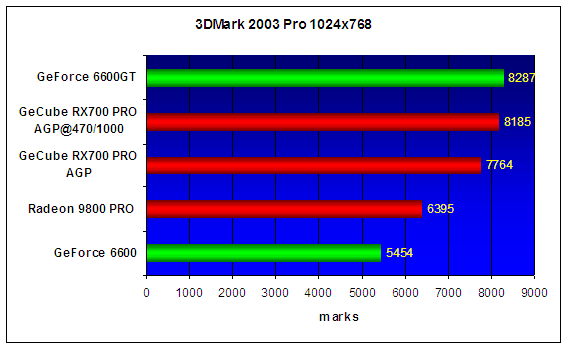 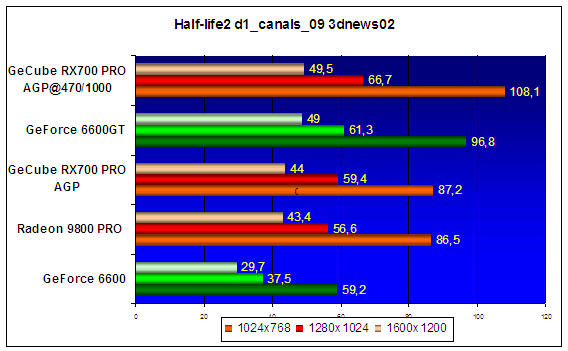 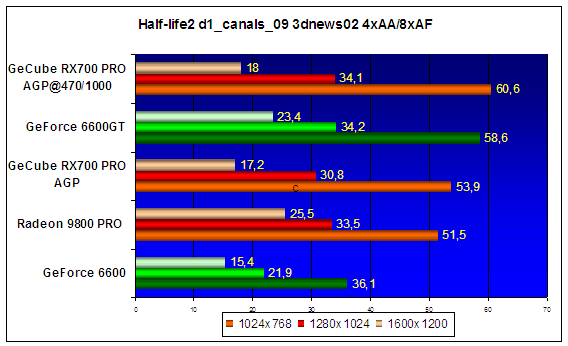 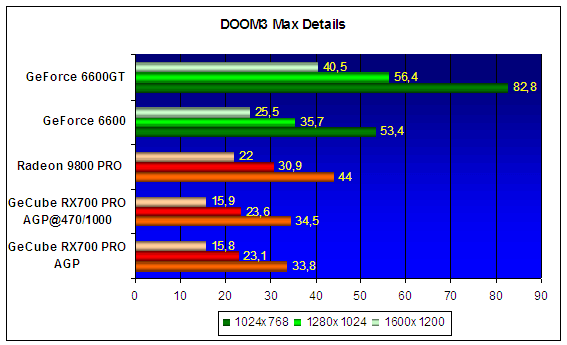 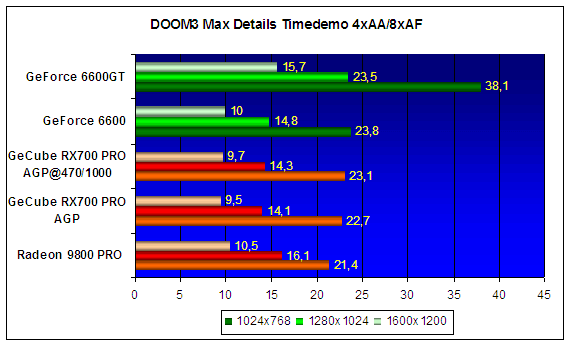 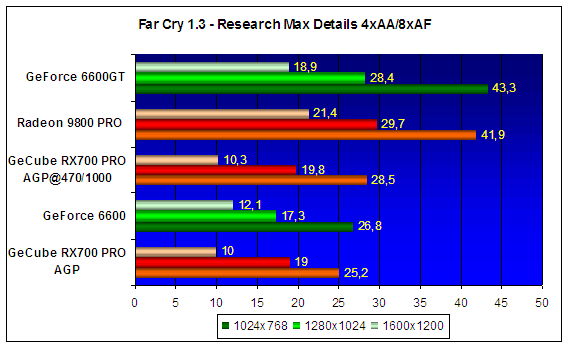 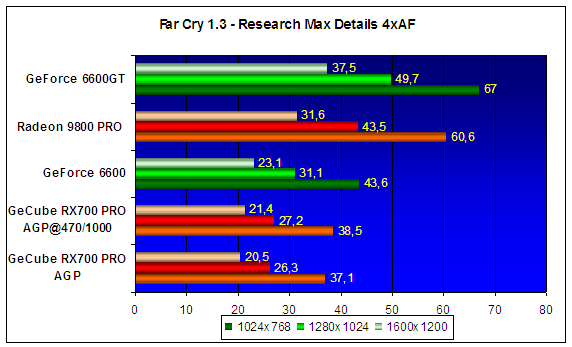 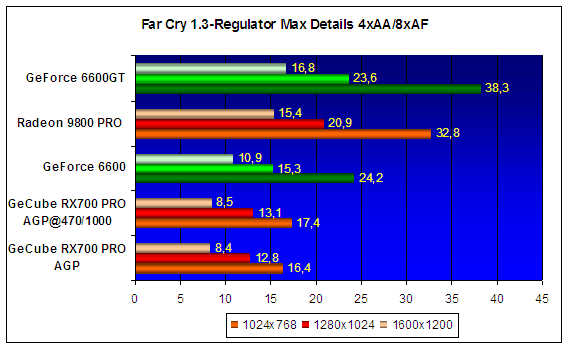 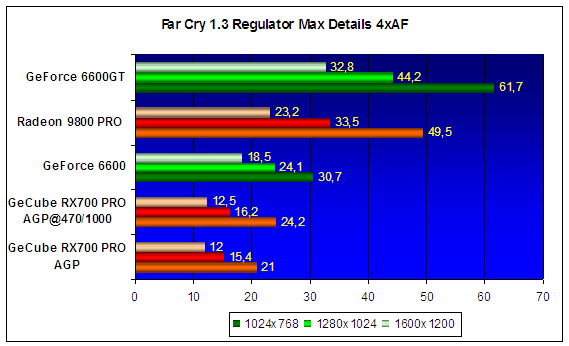 Performance and conclusions In view of the $149 recommended by ATI, we found ourselves in quite an ambiguous situation with performance comparison because GeForce 6600GT (starting at $170) costs a bit more, and GeForce 6600 (starting with $110) is already cheaper. Of course, all these figures are strongly dependent on the manufacturer and sales outlets, and you can easily comes across the 6600 even at $150 if you to set your mind on getting that. Another question which comes up - is such a buy optimum? It's up to you to decide. Well, what do we get if we decide to save and buy the cheaper GeForce 6600 instead of the 128-Mb novelty by ATI?! Although at synthetic benchmarks the RX700 PRO takes a sure lead over 6600, the situation somehow changes at games, which is another proof that synthetic benchmarks sometimes give a poor idea of the real performance, and you should take the results with a pinch of salt. In this case we see a definite leadership of 6600 at Far Cry (in both demos) and at DOOM3, whereas at HL2 the RX700 PRO is a better performer. But it should be noted that you should buy these cards keeping in mind that your maximum resolution in most ways will be 1280x1024. Another thing - you'd have to be more neat and somehow slim down regarding АА and AF. But what if you pay a bit to the available $150 and buy GeForce 6600GT? That is all absolutely clear and needs no special comments. Note only that in the test we used GeForce 6600GT running at frequencies 500/900MHz, which is standard for the AGP-version. We are bringing in this information in order to exclude probable questions because the market also offers AGP GeForce 6600GT with the originally higher standard frequencies. So, what about Radeon 9800 PRO?! It's still a bit early to rule out this card - at most tests it proved to be a better performer that our novelty. As long as the price difference between 9800 PRO and RX700 PRO is about $20-30 at least, it makes sense thinking twice. If later on as the market gets more saturated with RX700 PRO, their price will be somehow different. On the other hand, 9800PRO at $170 to date can hardly be regarded as a modern buy because with the same money you'd better get the more powerful GeForce 6600GT which is more advanced in terms of supported technologies. Summing it all up, we can note the emergence of two more merited products based on the Х700 PRO in the retail - the 128Mb and 256Mb modifications. Regarding the latter, we'll surely introduce it in the nearest future because the mainstream market of AGP cards is a topic of high interest to most consumers to date. We appreciate GeCube for the GeCube RX700 PRO video card presented for tests. We are thankful to ASUS and Kingston Technology for the hardware to build the test bench. |
|
|||||